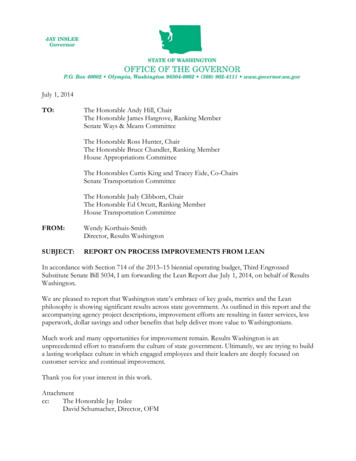
Transcription
July 1, 2014TO:The Honorable Andy Hill, ChairThe Honorable James Hargrove, Ranking MemberSenate Ways & Means CommitteeThe Honorable Ross Hunter, ChairThe Honorable Bruce Chandler, Ranking MemberHouse Appropriations CommitteeThe Honorables Curtis King and Tracey Eide, Co-ChairsSenate Transportation CommitteeThe Honorable Judy Clibborn, ChairThe Honorable Ed Orcutt, Ranking MemberHouse Transportation CommitteeFROM:Wendy Korthuis-SmithDirector, Results WashingtonSUBJECT:REPORT ON PROCESS IMPROVEMENTS FROM LEANIn accordance with Section 714 of the 2013–15 biennial operating budget, Third EngrossedSubstitute Senate Bill 5034, I am forwarding the Lean Report due July 1, 2014, on behalf of ResultsWashington.We are pleased to report that Washington state’s embrace of key goals, metrics and the Leanphilosophy is showing significant results across state government. As outlined in this report and theaccompanying agency project descriptions, improvement efforts are resulting in faster services, lesspaperwork, dollar savings and other benefits that help deliver more value to Washingtonians.Much work and many opportunities for improvement remain. Results Washington is anunprecedented effort to transform the culture of state government. Ultimately, we are trying to builda lasting workplace culture in which engaged employees and their leaders are deeply focused oncustomer service and continual improvement.Thank you for your interest in this work.Attachmentcc:The Honorable Jay InsleeDavid Schumacher, Director, OFM
STATE OF WASHINGTONLEAN PROCESS IMPROVEMENTS AND EFFICIENCIESReport to the LegislatureRESULTS WASHINGTONJuly 2014
This report is submitted by Results Washington and the Office of Financial Managementpursuant to Section 714 of Third Engrossed Substitute Senate Bill 5034 (2013), whichstates, in part:Agencies must report to the office of financial management at least twice per fiscal yearprocess improvements and efficiencies gained through tools such as the lean strategy. Theoffice of financial management must compile and transmit these reports to the appropriatefiscal committees of the legislature at least every six months, beginning January 1, 2014.This is our second report. We anticipate submitting the next one February 1, 2015. Byreporting to the Legislature in February rather than in January, agencies are able to track andreport their efforts to us in line with their regular, six-month calendar cycles (Januarythrough June and July through December). This one-time adjustment will put us on track forregular six-month reporting cycles that match up with the agencies’ own semiannual trackingefforts.To accommodate persons with disabilities, this document is available in alternate formats bycalling Results Washington at 360-902-0591. TTY/TDD users should contact Results Washingtonvia the Washington Relay Service at 711 or 1-800-833-6388.Visit our website at www. results.wa.gov1
ContentsExecutive summary . 3Lean partners . 3Examples of Lean results . 4Previous and ongoing efforts . 5Results Washington . 6Organizational and cultural change . 8Building a Lean culture enterprise-wide . 9 Lessons in Leadership . 9 Lean conference . 9 Lean practitioner community of practice . 9 Lean agency advisor community of practice .10 Lean fellowship program .10 Agile .10The road ahead .10Appendix A: Performance management in Washington .11Appendix B: Detailed Lean improvement project reports .122
Executive summaryWashington state’s embrace of key goals, metrics and the Leanphilosophy is starting to show significant results across stategovernment. Using Lean methods and principles, agencies arefocusing on customers in a deliberate way and empoweringfront-line workers to make improvements.As shown in the summary and project reports below, thesechanges are reflected in:››››››››faster servicesslashed backlogsless paperworkdollar savingseasier-to-understand formshigher customer satisfactionengaged employeesmore staff time for mission-critical workCumulatively, Lean changes since 2012 have savedWashingtonians millions of dollars, and in the case of drivers’licenses at the Department of Licensing, more than a century’sworth of waiting time. Permits are being issued more quickly.Public record requests are being fulfilled faster. Changes in workflow and elimination of redundancies and bottlenecks areleading to greater quality of applications and faster, consistentreviews and inspections.Much work and many opportunities for improvement remain.While focusing on improving education, health, the economyand the environment, Results Washington is also anunprecedented effort to transform the culture of stategovernment. Ultimately, we’re building a lasting workplaceculture in which engaged employees and their leaders arestrongly focused on customer service and continualimprovement.Building a Lean culture enterprise-wide is a major organizationaltransformation, and our Lean journey is still at the early stages.Although many states are embracing performance management,none is approaching it on as ambitious a scale as Washington is.Department of Labor and IndustriesCut the average time for processingemployer requests for reconsiderationof audit findings from 441 days to 67,saving employers an estimated 1.7million in interest costs.Department of RevenueReduced by 64 percent the averagenumber of days an informationservices help desk ticket is open.Department of HealthCut the time for handling a complaintabout the Women, Infants andChildren program from an average offour weeks to one.Department of Social andHealth ServicesStreamlined a widely used personnelform and processes, eliminating theneed for 8,000 approval signaturesand saving 2,133 hours of staff timeeach month.Department of TransportationWSDOT headquarters has cut the timeit takes to fulfill public disclosurerequests by 55 percent, from anaverage of 24 days to 11.Lean partnersWashington has benefitted tremendously from the assistance of 192 Lean partners from 86 publicand private-sector organizations who have provided their expertise — for free — to state employeeslearning Lean and doing improvement work.3
These partners represent several sectors, including:› manufacturing› aerospace› the military› health care› higher education› insuranceThese experts have provided training, coaching, tours orconsulting to leaders and line staff involved in Lean improvementefforts at dozens of agencies.Through the efforts of the Results Washington team and thesepublic and private-sector partners, thousands of state employeeshave been introduced to Lean principles and tools, as havehundreds of state managers and supervisors. Hundreds of Leanprojects have been launched at dozens of agencies. We have heardover and over from employees who began this process skeptically,only to be convinced as they saw their own workspaces andworkflow improve.In a time of limited resources for government to provide essentialservices, Lean helps to manage the work and improve the results.Examples of Lean resultsDuring this six-month reporting period, 33 agencies, boards andcommissions have submitted 115 detailed Lean improvementproject reports. The boxes on the right-hand side of this report’spages are taken from project reports during this January 1, 2014,through May 31, 2014, reporting period.Department of TransportationFerries Division now requires onlythree signatures per item for mostcontracts and purchase ordersinstead of six or seven.Department of LicensingCut by more than half the timerequired for DOL Mail Center toreceive and forward firearms transferapplications from licensed firearmdealers to program staff forprocessing.Office of the Family andChildren’s OmbudsImproved an inefficient, paper-basedcomplaint process by adding theoption of a faster, easy-to-completeonline version.Community Colleges of SpokaneReduced by two-thirds the numberof steps a student takes fromadmission to sitting in class.Those project reports are attached to this document as Appendix B. They detail the problem thateach improvement effort addressed, what was done about it and specific results achieved.4
The agencies reporting improvement projects during this period include:Department of AgricultureEmployment Security DepartmentDepartment of CommerceHealth Care AuthorityConsolidated Technology ServicesLiquor Control BoardDepartment of CorrectionsWashington’s LotteryDepartment of EcologyMilitary DepartmentEmployment Security DepartmentOffice of Administrative HearingsDepartment of Enterprise ServicesOffice of the Chief Information OfficerEnvironmental and Land Use Hearings OfficeOffice of the Family and Children’s OmbudsDepartment of Financial InstitutionsOffice of Financial ManagementDepartment of Fish and WildlifePollution Liability Insurance AgencyDepartment of HealthRecreation and Conservation OfficeDepartment of Labor and IndustriesState Board for Community and Technical Colleges*Department of LicensingState Conservation CommissionDepartment of Retirement SystemsUtilities and Transportation CommissionDepartment of RevenueWashington Student Achievement CouncilDepartment of Social and Health ServicesWashington State PatrolDepartment of TransportationWashington Traffic Safety Commission* The State Board for Community and Technical Colleges report includes project and training information from Big Bend Community College, ClarkCollege, Edmonds Community College, Everett Community College, Highline Community College, Olympic College, Pierce Colleges, Seattle Collegesand Community Colleges of Spokane.Previous and ongoing effortsOver the past 2.5 years, agencies across Washington stategovernment have used Lean principles on an estimated 500improvement projects.Much of the initial work was limited in scope, as employees andmanagers began to learn the tools and philosophy of Lean. Butas their comfort level has risen, agencies have accomplishedsubstantial Lean-driven gains in efficiency, effectiveness andcustomer service.Among them:› The Washington State Patrol and the Department ofEnterprise Services worked together to overhaul an archaicpaper application system for trooper candidates. The Patrolhas also used Lean to dramatically speed up backgroundchecks and how quickly mechanics outfit patrol cars. AndDES has been a leader using Lean, with many improvementsunderway.Consolidated Technology ServicesAutomated a monthly report aboutservice desk workload, so a manualprocess that used to take 24-30 hoursof staff time every month now takesminutes. The saved staff time is nowused on other work, including directcustomer service.Department of LicensingCut the customer wait time from 24hours to 15 minutes for peoplereinstating a driver’s license afterpreviously paying with a dishonoredcheck.5
› The Health Care Authority’s Medical Assistance Customer››››Service Center used Lean process improvements to reducea backlog of 400 unresolved client complaints aboutproviders by more than 70 percent.The Office of the Chief Information Officer broughttogether 11 agencies to work on a shared mailing addresssystem, saving duplication of effort and ensuring that whenone agency makes a correction, all of them get the updatedinformation. Savings are projected at 1.6 million per year.The Department of Revenue’s Taxpayer Services division,which faces a flood of calls from tax filers every January,made a number of employee-suggested improvements. Itcreated a much simpler form for businesses that owe littlein taxes. It made returns available to customers earlier.And it launched an online chat service to respond toquestions. Wait times for customers are much lower andthe work is more manageable.The Department of Social and Health Services has usedLean to speed up Child Protective Services investigations.It has worked closely with stakeholders to make clientnotices shorter and easier to understand. DSHS has alsoused Lean processes to sharply reduce costs of client Xrays. And it’s worked with the Employment SecurityDepartment to better help DSHS clients searching forwork.The Liquor Control Board, which received a flurry ofpublic disclosure requests related to marijuana legalization,has nearly cut in half the time it takes to respond.Results WashingtonDepartment of TransportationEliminated an 8.5-month backlog ofcollision data reports. Fully analyzedcollision records are now processed infive days
The Washington State Patrol and the Department of Enterprise Services worked together to overhaul an archaic paper application system for trooper candidates. The Patrol has also used Lean to dramatically speed up background checks and how quickly mechanics outfit patrol cars. And DES has been a leader using Lean, with many improvements underway.











